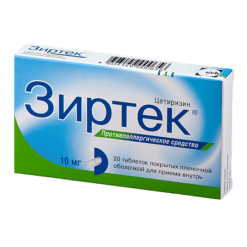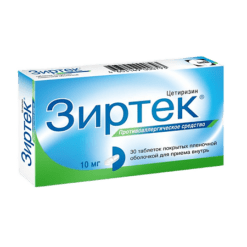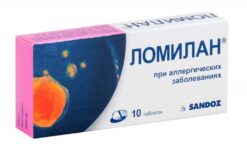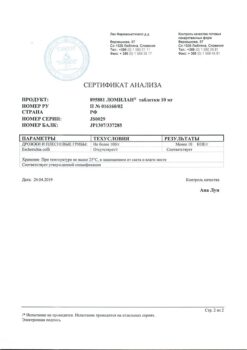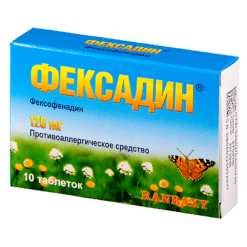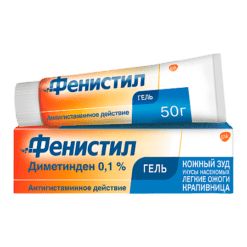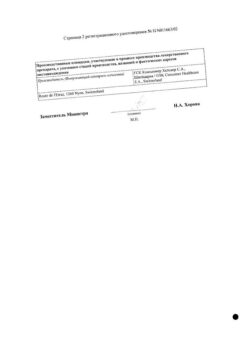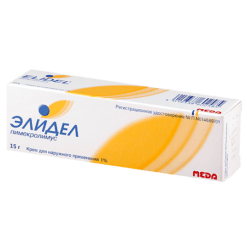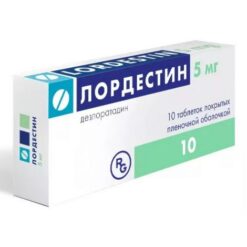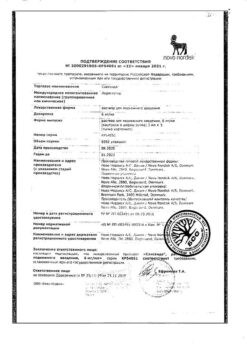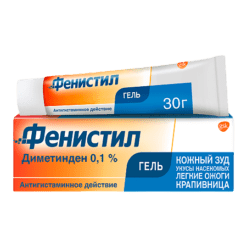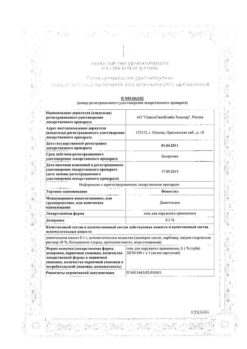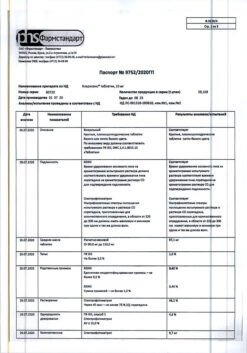No products in the cart.
Description
Zyrtec is an antihistamine, anti-allergic.
Pharmacodynamics
Cetirizine – the active substance of the drug Zyrtec® – is a metabolite of hydroxyzine, belongs to the group of competitive histamine antagonists and blocks H1-histamine receptors.
Cetirizine prevents the development and facilitates the course of allergic reactions, has antipruritic and antiexudative actions. Cetirizine affects the early histamine-dependent stage of allergic reactions, limits the release of inflammatory mediators at the later stage of the allergic reaction, and also reduces migration of eosinophils, neutrophils and basophils and stabilizes mast cell membranes. It reduces capillary permeability, prevents the development of tissue edema, relieves smooth muscle spasm. Eliminates the skin reaction to the introduction of histamine, specific allergens, as well as cooling (in cold urticaria). Reduces histamine-induced bronchoconstriction in mild bronchial asthma.
Cetirizine has no anticholinergic and antiserotonin effects. In therapeutic doses the drug practically does not cause a sedative effect. After a single dose of 10 mg of cetirizine it causes the action in 20 minutes (in 50% of patients), in 60 minutes (in 95% of patients) and lasts more than 24 hours. During a course of treatment, tolerance to the antihistamine effect of cetirizine does not develop. After discontinuation of therapy the effect lasts up to 3 days.
Pharmacokinetics
The pharmacokinetic parameters of cetirizine change linearly.
Intake. After oral administration the drug is quickly and completely absorbed from the gastrointestinal tract. Food intake does not affect the completeness of absorption, although its speed decreases. In adults after a single use of the drug in a therapeutic dose Cmax in plasma is 300 ng/ml and is reached in (1±0.5) hours.
Distribution. Cetirizine is (93±0.3)% bound to plasma proteins. Vd is 0.5 l/kg. No cetirizine cumulation is observed when taking the drug in a dose of 10 mg for 10 days.
Metabolism. In small amounts, it is metabolized in the body by O-dealkylation (unlike other H1-histamine receptor antagonists, which are metabolized in the liver via the cytochrome system) to form a pharmacologically inactive metabolite.
Elimination. In adults, T1/2 is approximately 10 h; in children from 6 to 12 years, 6 h; from 2 to 6 years, 5 h; from 6 months to 2 years, 3.1 h. About 2/3 of the taken dose of the drug is excreted unchanged by the kidneys.
In elderly patients and patients with chronic liver disease in single use of the preparation in dose of 10 mg T1/2 is increased approximately by 50%, and systemic clearance is decreased by 40%.
In patients with mild renal impairment (creatinine Cl >40 ml/min), the pharmacokinetic parameters are similar to those in patients with normal renal function.
In patients with moderate renal insufficiency and in patients on hemodialysis (creatinine Cl1/2 is increased by a factor of 3 and total clearance is decreased by 70% relative to these parameters in patients with normal renal function, which requires appropriate changes in dosing regimen.
Cetirizine is almost not eliminated from the body by hemodialysis.
Indications
Indications
Cetirizine dihydrochloride oral drops 10 mg/ml is indicated in adults and children 6 months and older for the relief of:
– nasal and ocular symptoms of year-round (persistent) and seasonal (intermittent) allergic rhinitis and allergic conjunctivitis: itching, sneezing, nasal congestion, rhinorrhea, lacrimation, conjunctival hyperemia;
– symptoms of chronic idiopathic urticaria.
Use in children from 6 to 12 months is possible only as prescribed by a doctor and under strict medical supervision.
Pharmacological effect
Pharmacological effect
Zyrtec – antihistamine, antiallergic.
Pharmacodynamics
Cetirizine, the active substance of Zyrtec®, is a metabolite of hydroxyzine, belongs to the group of competitive histamine antagonists and blocks H1 histamine receptors.
Cetirizine prevents the development and alleviates the course of allergic reactions, has antipruritic and antiexudative effects. Cetirizine affects the early histamine-dependent stage of allergic reactions, limits the release of inflammatory mediators at the late stage of the allergic reaction, and also reduces the migration of eosinophils, neutrophils and basophils, and stabilizes mast cell membranes. Reduces capillary permeability, prevents the development of tissue edema, relieves spasm of smooth muscles. Eliminates skin reactions to the introduction of histamine, specific allergens, as well as cooling (with cold urticaria). Reduces histamine-induced bronchoconstriction in mild bronchial asthma.
Cetirizine does not have anticholinergic and antiserotonin effects. In therapeutic doses, the drug practically does not cause a sedative effect. After taking cetirizine in a single dose of 10 mg, its effect develops after 20 minutes (in 50% of patients), after 60 minutes (in 95% of patients) and lasts more than 24 hours. During a course of treatment, tolerance to the antihistamine effect of cetirizine does not develop. After discontinuation of therapy, the effect lasts up to 3 days.
Pharmacokinetics
The pharmacokinetic parameters of cetirizine change linearly.
Suction. After oral administration, the drug is quickly and completely absorbed from the gastrointestinal tract. Eating does not affect the completeness of absorption, although its speed decreases. In adults, after a single dose of the drug in a therapeutic dose, Cmax in blood plasma is 300 ng/ml and is achieved after (1±0.5) hours.
Distribution. Cetirizine is (93±0.3)% bound to blood plasma proteins. Vd is 0.5 l/kg. When taking the drug at a dose of 10 mg for 10 days, no accumulation of cetirizine is observed.
Metabolism. In small quantities, it is metabolized in the body by O-dealkylation (unlike other H1-histamine receptor antagonists, which are metabolized in the liver using the cytochrome system) to form a pharmacologically inactive metabolite.
Excretion. In adults, T1/2 is approximately 10 hours; in children from 6 to 12 years – 6 hours, from 2 to 6 years – 5 hours, from 6 months to 2 years – 3.1 hours. Approximately 2/3 of the dose taken is excreted unchanged by the kidneys.
In elderly patients and patients with chronic liver diseases, with a single dose of 10 mg, T1/2 increases by approximately 50%, and systemic clearance decreases by 40%.
In patients with mild renal failure (Cl creatinine >40 ml/min), pharmacokinetic parameters are similar to those in patients with normal renal function.
In patients with moderate renal failure and in patients on hemodialysis (Cl creatinine1/2 increases 3 times, and total clearance decreases by 70% relative to these indicators in patients with normal renal function, which requires a corresponding change in the dosage regimen.
Cetirizine is practically not removed from the body during hemodialysis.
Special instructions
Special instructions
In patients with spinal cord injury, prostatic hyperplasia, as well as in the presence of other factors predisposing to urinary retention, caution is required, because Cetirizine may increase the risk of urinary retention.
It is recommended that you avoid drinking alcohol (see Interactions).
Impact on the ability to drive vehicles and operate machinery. An objective assessment of the ability to drive vehicles and operate machinery did not reliably reveal any adverse events when taking the drug at the recommended dose. But nevertheless, during the period of taking the drug, it is advisable to refrain from engaging in potentially hazardous activities that require increased concentration and speed of psychomotor reactions.
Due to the potential for CNS depressant effects, caution should be exercised when prescribing Zyrtec® to children under 1 year of age who have the following risk factors for sudden infant death syndrome, such as (but not limited to):
sleep apnea syndrome or sudden infant death syndrome in a sibling;
maternal drug abuse or smoking during pregnancy;
young maternal age (19 years and younger);
Smoking abuse by a nanny caring for a child (one pack of cigarettes a day or more);
children who regularly fall asleep face down and are not placed on their back;
premature (gestational age less than 37 weeks) or low birth weight (below 10th percentile of gestational age) children;
when taking drugs together that have a depressant effect on the central nervous system.
The drug contains excipients methylparabenzene and propylparabenzene, which can cause allergic reactions, incl. slow type.
Active ingredient
Active ingredient
Cetirizine
Composition
Composition
Active ingredient:
cetirizine hydrochloride 10 mg;
Excipients:
glycerol – 250 mg;
propylene glycol – 350 mg;
sodium saccharinate – 10 mg;
methylparabenzene – 1.35 mg;
propylparabenzene – 0.15 mg;
sodium acetate – 10 mg;
glacial acetic acid – 0.53 mg;
purified water – up to 1 ml
Pregnancy
Pregnancy
Pregnancy
An analysis of prospective data from more than 700 cases of pregnancy outcomes revealed no cases of developmental malformations of embryonic and neonatal toxicity with a clear cause-and-effect relationship.
Experimental studies in animals have not revealed any direct or indirect adverse effects of cetirizine on the developing fetus (including in the postnatal period), pregnancy and postnatal development.
Adequate and strictly controlled clinical studies on the safety of the drug during pregnancy have not been conducted; therefore, Zirtec® should not be used during pregnancy.
Breast-feeding
Cetirizine is excreted in breast milk in concentrations ranging from 25% to 90% of the drug concentration in the blood plasma, depending on the time after administration. During breastfeeding, it is used after consultation with a doctor if the expected benefit to the mother outweighs the potential risk to the child.
Fertility
Available data on the effects on human fertility are limited; however, no negative effects on fertility have been identified.
Contraindications
Contraindications
– Hypersensitivity to cetirizine hydroxyzine or any piperazine derivatives as well as other components of the drug;
– end-stage renal failure (creatinine clearance < 10 ml/min);
– children up to 6 months of age (due to limited data on the effectiveness and safety of the use of the drug Zyrtec®;
– pregnancy.
With caution:
Side Effects
Side Effects
From the immune system: rarely – hypersensitivity reactions; very rarely – anaphylactic shock.
From the nervous system: often – headache, increased fatigue, dizziness, drowsiness; infrequently – paresthesia; rarely – convulsions; very rarely – taste perversion, dyskinesia, dystonia, fainting, tremor, tic; frequency unknown – memory impairment, incl. amnesia.
Psychiatric disorders: uncommon – agitation; rarely – aggression, confusion, depression, hallucinations, sleep disturbance; frequency unknown – suicidal ideation.
From the organ of vision: very rarely – disturbance of accommodation, blurred vision, nystagmus.
On the part of the hearing organ: frequency unknown – vertigo.
From the digestive system: often – dry mouth, nausea; infrequently – diarrhea, abdominal pain.
From the cardiovascular system: rarely – tachycardia.
From the respiratory system: often – rhinitis, pharyngitis.
Metabolism: rarely – weight gain.
From the urinary system: very rarely – dysuria, enuresis; frequency unknown – urinary retention.
From the laboratory parameters: rarely – changes in liver function tests (increased activity of liver transaminases, alkaline phosphatase, GGT and bilirubin concentration); very rarely – thrombocytopenia.
On the skin: infrequently – rash, itching; rarely – urticaria; very rarely – angioedema, persistent erythema.
General disorders: infrequently – asthenia, malaise; rarely – peripheral edema; frequency unknown – increased appetite.
Interaction
Interaction
When studying the drug interactions of cetirizine with pseudoephedrine, cimetidine, ketoconazole, erythromycin, azithromycin, diazepam, glipizide and antipyrine, no clinically significant adverse interactions were identified.
When used simultaneously with theophylline (400 mg/day), the total clearance of cetirizine is reduced by 16% (theophylline kinetics does not change).
When used concomitantly with ritonavir, the AUC of cetirizine increased by 40%, while that of ritonavir changed slightly (−11%).
When used simultaneously with macrolides (azithromycin, erythromycin) and ketoconazole, no changes were observed on the ECG.
When using the drug in therapeutic doses, no data on interaction with alcohol were obtained (at a blood alcohol concentration of 0.5 g/l). However, you should refrain from drinking alcohol during drug therapy to avoid central nervous system depression.
Before prescribing allergy tests, a three-day “washing out” period is recommended due to the fact that H1-histamine receptor blockers inhibit the development of skin allergic reactions.
Overdose
Overdose
Symptoms (when taking the drug once at a dose of 50 mg): confusion, diarrhea, dizziness, fatigue, headache, malaise, mydriasis, itching, weakness, anxiety, sedation, drowsiness, stupor, tachycardia, tremor, urinary retention.
Treatment: immediately after taking the drug – gastric lavage or induction of vomiting. It is recommended to prescribe activated carbon and carry out symptomatic and supportive therapy. There is no specific antidote. Hemodialysis is ineffective.
Storage conditions
Storage conditions
At a temperature not exceeding 30 °C.
Shelf life
Shelf life
5 years
Manufacturer
Manufacturer
UCB Farma, Belgium
Additional information
| Shelf life | 5 years |
|---|---|
| Conditions of storage | At a temperature not exceeding 30 °C. |
| Manufacturer | UCB Farma, Belgium |
| Medication form | oral drops |
| Brand | UCB Farma |
Other forms…
Related products
Buy Zyrtec, drops 10 mg/ml 20 ml with delivery to USA, UK, Europe and over 120 other countries.


